Air conditioning and split system - what's the difference? Differences and criteria for choosing climate control equipment
When choosing equipment to ensure a comfortable microclimate in the room, due to inexperience, you can get lost among the huge variety of models. Such climate control equipment differs in capabilities, technical characteristics and internal structure.
The most common options are a monoblock air conditioner and a split system - what is the difference between them, which unit is better to use? Let's take a closer look at the features of these electrical appliances and the nuances of their choice.
The content of the article:
Existing air conditioning systems
To create the most comfortable living and working conditions for a person, various climate control equipment must be installed in the premises.
Most often, this is a regular air conditioner - a device designed to maintain the humidity and air temperature in the room at optimal values for people.
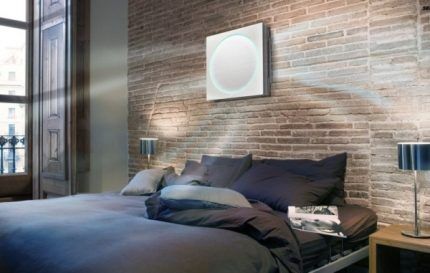
Gradually, such equipment is turning from an optional luxury item into an ordinary household appliance found in many homes. And today it’s hard to imagine an office without such air conditioning equipment. Everyone wants to work and live in the most comfortable conditions possible.
A simple air conditioner with a minimum set of functions costs about 10-25 thousand rubles - a quite affordable price. For this money, the buyer receives a device capable of not only cooling, drying and cleaning, but also, under certain conditions, slightly heating the room air.
General operating principle
In many ways, an air conditioner resembles a refrigerator. In both cases, there is a refrigerant circulating in a closed circle - usually freon. At the same time, it constantly evaporates in one place of the system and condenses in another.
When evaporating, freon absorbs, and when condensing, it releases heat. Pure physics, no mysticism. As a result of these transformations, thermal energy is taken from one heat exchanger and released to another. Scientifically, it is a vapor-compression refrigeration cycle.
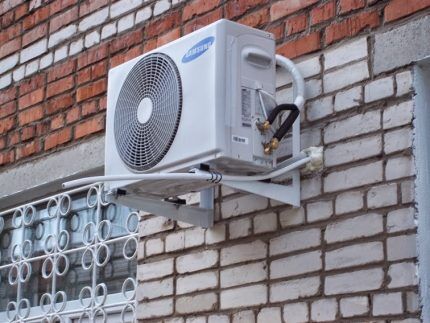
All climate control equipment is energy-dependent equipment. Without power supply, these devices cannot function.
If a room is left without electricity due to a network failure, then the devices in question for maintaining a comfortable microclimate immediately stop working. You should not forget about this point when choosing equipment. If there are problems with power supply, then you should take care household uninterruptible power supply.
Types of climate control equipment
Any air conditioner inside has two working units - the first serves to take in heat, and the second to release it. They are connected to each other by pipes containing refrigerant. At the same time, in some air conditioning systems all these elements are combined in a single device, while in others they are separated into a pair of separate modules.
The entire range of air conditioners is divided into three groups:
- monoblocks;
- split systems;
- multi split systems.
The devices of the first group are a classic all-in-one air conditioner. Devices from the second are divided into two blocks - internal for installation in the room and external for the street.
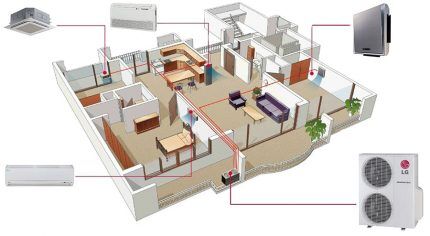
Monoblock air conditioners are divided into mobile models and window devices. Some are installed on the floor and, if necessary, can be moved from place to place, while others are mounted in the window opening.
Split system. The word "split" means division. Essentially, it is an air conditioner divided into parts.
The outdoor unit, which releases heat outside, contains a high-pressure freon preparation device and an external heat exchanger-condenser. And the module inside the room has an air filter, an evaporator heat exchanger, a fan and a drainage pump with a condensate tray.
Indoor split system units are:
- ceiling/duct;
- wall-mounted;
- floor/column.
From the wall version, cooled air is blown by a fan onto the wall opposite, and from the ceiling version it diverges along the ceiling to the sides and from top to bottom. The column model blows air currents up into the ceiling, from which they then move throughout the room.

The main difference between a split system and a monoblock air conditioner is the division of the air conditioning device into two blocks. In a split, the noisiest elements are placed outside so as not to disturb those inside the room with their buzzing while working.
Difference from evaporative coolers
In addition to classic air conditioners with refrigerant, there is another type of climate control equipment with similar functionality - water evaporators. There is no freon in these devices and there is no need for it.
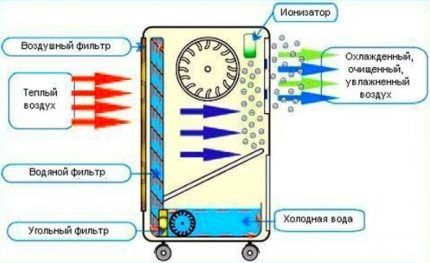
Household evaporative coolers are more compact and consume less energy than their freon-based counterparts. However, the water evaporating in them inevitably enters the cooled room, increasing the room humidity.
As a result, with long-term operation of such a cooler, the interior decoration and furniture in the room begin to deteriorate.
Unlike freon split systems and air conditioners, the evaporator is not able to heat and dry the air - on the contrary, the cooler only constantly humidifies it. Plus, such a device constantly needs to add water.
In a dry region or for short-term use, this option is acceptable, but often it will be more practical to take a device with a refrigerant and more functionality.
Criteria for choosing climate control equipment
Only with a clear understanding of the needs, the choice of climate control equipment will be optimal in terms of money and functionality.
Therefore, when choosing an air conditioner, you should consider it:
- performance/power;
- requirements for operating conditions and functionality;
- noise level;
- the cost of a specific model;
- installation price.
Also, do not forget about the built-in ionizers and additional air filters. Often they are not needed, but they give a considerable markup.
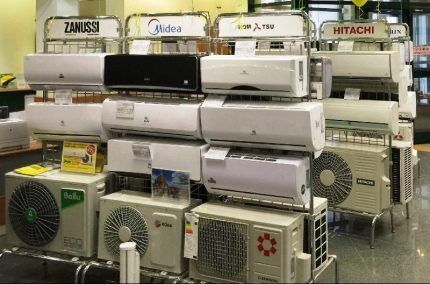
If you only need to cool the air and the room is small, then it is best to purchase a simple cooler. Unlike an air conditioner, it is not as noisy and costs less. But in other cases you will have to choose between a two-block split system and a window or floor monoblock.
Factor #1 - noise and power
The most important criterion for choosing a model of climate control equipment is the level of noise emitted by this equipment during operation. If the selected equipment makes a lot of noise, it will cause discomfort.
And here it doesn’t matter how well the air is cooled. The rustling sound of a fan is one thing, but the hum of a running compressor is quite another.
If the noise in the room needs to be reduced to a minimum, then only a split system should be used. By this criterion, a conventional monoblock air conditioner loses to it in this matter quite strongly.

A working split system produces sound at a level of 45–55 dB. The noise of a mobile air conditioner is 50–60 dB. And its window analogue will produce even more, plus the rattling of glass in the window will be added.
The difference in decibels is small at first glance. However, the constant hum can drive you crazy.The less noise the air conditioning equipment makes, the better. This is especially true when there are small children in the house or the air conditioner is installed in the study. There is a clear advantage here for the split system.
In terms of performance, the monoblock also loses to the two-block system. The more powerful the equipment, the larger and heavier it is. In a split, a more efficient compressor in the outdoor unit is not a problem. You simply can't see it outside the window. How big and noisy it is is not so important for most buyers.
The monoblock has serious limitations in this regard. Inserting a powerful compressor into it means filling the room with noise and making the device enormous in size. This option becomes unsuitable for installation in a window and loses its mobility when installed on the floor.
The floor-standing monoblock looks great in the interior, and when not needed, it can be easily stored in a closet, utility room or further away in a corner. However, it will not cope with cooling a large room.

Even if you turn it on at full power, in extreme heat outside the window it is not always able to fulfill its purpose. Plus, under such operating modes, the device will quickly overheat and may burn out. Here it is better to rely on a split system.
To simplify calculate the required power equipment (Q), must be added:
- Q1 – represents the sum of heat inflows emanating from the windows, walls and ceiling of the room;
- Q2 – heat generated by people in the room;
- Q3 – the amount of thermal energy released by household appliances.
Each person in the room generates about 100–150 W of heat. Q2 It's easy to calculate. To calculate Q1 you need to multiply 30–45 W by the cubic capacity of the room. Plus, the rated power of computers, televisions, lighting devices and all other household appliances is added to this, multiplied by 0.3.
To the resulting total amount, 10–15% is added in reserve. And you can go choose an air conditioner. If there is a model of a mobile air conditioner for the calculated data, then you can purchase it.
But often the required power is quite high. Then to cover it - remove excess heat from a particular room, you have to take a split system.
Factor #2 - cost of equipment and installation
In terms of equipment price, household air conditioners do not differ much from split systems of similar power, but the higher the performance, the more noticeable this difference is. The first option in a mobile version with 1.5–2.5 kW costs approximately 10–15% cheaper than the second with similar kilowatts.
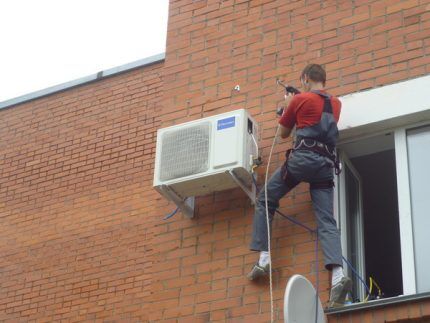
The difference is insignificant, but we must also add the cost of installation work. To operate a floor-standing monoblock, simply place it in the room and plug it into the network.
A split system must first be installed indoors and outdoors, and then the outdoor and indoor parts must be connected together. As a result, the total costs of setting up the system are far from the same.
If split installation They offer to do it cheaply - less than a third of the cost of the device, then you should be extremely careful. There is no saving in this matter. The connection between the external and internal blocks is made by copper tubes through which freon circulates.
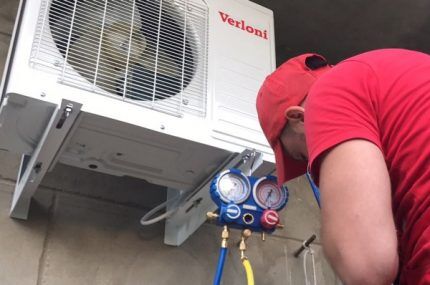
Also, the cost of installation is strongly influenced by the need to use special equipment for work at heights. If the split system is installed in an apartment on the upper floors of a tall building, then you may need to call a lift or invite an industrial climber. And this is always additional expenses.
Factor #3 - convenience and reliability
In terms of service life, a lot depends on air conditioner manufacturer and the quality of its installation. The outdoor unit of the split system has to endure the effects of various precipitation, wind and sudden changes in air temperature throughout the year.
And the monoblock is located indoors and is free from all this. It seems that the second option should obviously serve longer than the first.
However, the split system is initially designed taking into account climatic factors. Only there is a very important point in it - this is the quality of soldering of copper pipes with freon.
If the blocks are connected by a professional, then such a system often outperforms a monoblock air conditioner in terms of reliability and durability. But with unqualified installation, everything is exactly the opposite.
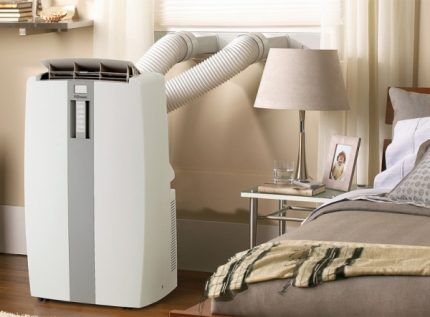
The monoblock is sold pre-assembled at the factory. It will definitely serve its warranty period. It takes some effort to disable it. You just need to correctly calculate the power of the equipment and not kick it accidentally.
In terms of available functions, split systems and monoblock air conditioners with comparable power indicators and prices are practically the same. Their cost is more affected by the manufacturer’s brand, as well as the presence of additional ionizers, filters and air dehumidifiers. There is no clear leader here. It is necessary to compare specific models.
Conclusions and useful video on the topic
From the video you can learn about the principles of operation of air conditioners:
What air conditioning equipment to choose for your home:
The difference between the inverter version of the air conditioner and the conventional one:
In the vast majority of cases, it is recommended to choose a split system for an apartment or cottage. A floor-standing mobile air conditioner in the form of a monoblock is more suitable for offices and retail outlets, where its appearance will not spoil the interior.
However, if you need the cheapest, low-power model, for example, to turn it on in a country house, garage or utility room, then the monoblock version will be the ideal choice.
Share with readers your experience of using a household air conditioner or split system. Tell us what the choice of unit was based on, and whether you are satisfied with the purchase. Please leave comments on the article, ask questions and participate in discussions. The contact form is located below.




At one time I wanted to buy a mobile air conditioner. I thought it was like a suitcase on wheels, drag it with you from room to room, but for the winter I hid it in the closet and forgot about it.
Yeah, of course! Mobility is questionable - it also needs to be connected to the street, a thick pipe needs to be inserted into the window. Then, collecting condensate in some kind of container, and in general, the prices for this type of air conditioners are abnormal. I bought a regular one and calmed down.
Its mobility lies in the fact that any average person can dismantle it and take it, for example, to a dacha or another apartment. And use it there.
Good afternoon, Egor. The American company Mobile Comfort “heard” citizens’ criticism of mobile air conditioners. Today there is a RoCo prototype that does not require a pipe. Serial production will start in 2021.
Let me explain how RoCo works - there is a radiator tank filled with liquid, which, when frozen, turns into an analogue of ice. True, its heat capacity is many times greater than that of water. The room air pumped through the radiator is cooled, and the “ice” melts in 8 hours. The air conditioner “charges” in a couple of hours. The air conditioner constantly monitors the location of the owner, directing the air stream towards him.
I never thought that the air conditioner installed in our office turns out to be not an air conditioner at all, but a split system. When we ordered it, they did not focus our attention on this point. And technical nuances are not so important to the average person. This is rather something that professionals need to know. And it is important for the client that the equipment works properly.